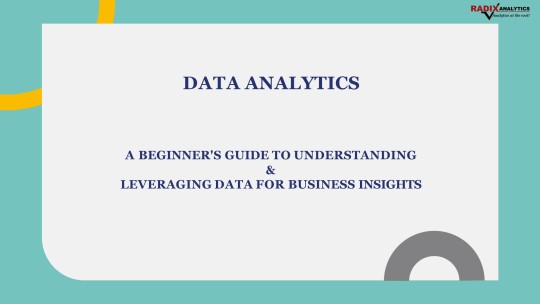#AIinAnalytics
Explore tagged Tumblr posts
Text
Gen AI in analytics
Generative AI is transforming data analytics through automated reporting, synthetic data generation, and fresh data visualizations. Yet challenges like data quality, ethics, and skill gaps remain. Explore how analysts can integrate generative AI into their workflows responsibly, harnessing new opportunities without losing the human touch. The future of analytics has to be a combination of human + AI skills:
https://www.futureofanalytics.net/blog-future-of-data-analytics/generative-ai-in-data-analytics-opportunities-challenges
0 notes
Text

ICYMI: The Four Pillars of Advanced Data Analytics: Descriptive, Diagnostic, Predictive, and Prescriptive https://kamyarshah.com/the-four-pillars-of-advanced-data-analytics-descriptive-diagnostic-predictive-and-prescriptive/
0 notes
Text
The Importance of Business Analytics: A Must-Have Skill You Need to Know Today
In today’s data-driven world, business analytics is essential for making informed decisions, improving efficiency, and gaining a competitive edge. It helps organizations analyze trends, identify opportunities, and solve complex problems using data insights. With the rise of AI and big data, mastering business analytics enables professionals to enhance decision-making, optimize strategies, and drive business growth. Whether in marketing, finance, or operations, this skill is a game-changer for success in any industry Read More..

0 notes
Text
Could AI Tools Like ChartPixel Fully Replace Human Analysts?

Imagine a future where AI tools like ChartPixel manage all aspects of data analysis autonomously. Could this lead to the complete replacement of human analysts, or is there still a crucial need for human insight in data interpretation?
Scenario: In this hypothetical future, AI tools like ChartPixel could autonomously process data, generate visualizations, and provide insights without any human input. This could revolutionize the way organizations handle data analysis.
Analysis:
Potential Benefits:
Speed and Efficiency: AI can analyze vast datasets quickly, providing immediate insights that humans might take longer to uncover.
Consistency in Results: Automated analysis ensures consistent outputs without the variability that human analysts might introduce.
Challenges:
Loss of Contextual Understanding: Can AI replicate the nuanced understanding that human analysts bring to complex data interpretations?
Critical Thinking Skills: Some analyses require deep critical thinking and contextual awareness that AI may not possess.
Do you think AI tools like ChartPixel could fully replace human analysts, or is human intuition essential? Would you trust AI to handle all aspects of your data analysis? Share your thoughts!
Join the discussion on the future of data analysis. Could AI replace human roles, or will human expertise always be necessary? Share your views and explore more at aiwikiweb.com/product/chartpixel/
#ChartPixel#FutureOfData#AIinAnalytics#HumanVsAI#DataAnalysis#TechDiscussion#Innovation#BusinessIntelligence#DigitalTransformation#SmartTools
0 notes
Text
How AI is the Key Differentiator in Analytics Products and Services

In the rapidly evolving healthcare industry, Artificial Intelligence (AI) is emerging as a game-changer, transforming the way healthcare analytics products and services operate. As data becomes increasingly central to healthcare, the ability to analyze and act on this data with speed and precision has never been more critical. AI is not just enhancing healthcare analytics; it is redefining what is possible, offering unprecedented opportunities for innovation and efficiency.
The Power of AI in Healthcare Analytics
AI brings to healthcare analytics the ability to process vast amounts of data quickly and accurately, enabling healthcare providers to make informed decisions in real time. Traditional data analysis methods often fall short in handling the complexity and volume of healthcare data. AI, with its advanced algorithms and machine learning capabilities, can analyze diverse data sets—from patient records to imaging studies—with a level of detail and speed that humans cannot match.
For example, AI can sift through millions of data points to identify patterns and correlations that would otherwise go unnoticed. This capability is particularly valuable in predictive analytics, where AI can forecast potential health outcomes based on historical data, helping clinicians to intervene early and improve patient outcomes.
AI as a Differentiator in Healthcare Products
AI's role as a differentiator in healthcare products is most evident in its ability to provide personalized healthcare solutions. AI-powered analytics tools can tailor treatments and interventions to the individual needs of patients, taking into account their unique medical histories, genetic profiles, and lifestyle factors. This personalized approach not only improves patient outcomes but also enhances patient satisfaction, as individuals receive care that is specifically designed for them.
Moreover, AI-driven healthcare products are increasingly integrating with wearable technology, allowing for continuous monitoring of patients and real-time data collection. This integration enables a proactive approach to healthcare, where potential issues can be identified and addressed before they become serious problems.
Transforming Healthcare Services with AI
In addition to enhancing products, AI is revolutionizing healthcare services. AI-powered chatbots and virtual assistants are becoming commonplace in patient care, offering 24/7 support and freeing up healthcare professionals to focus on more complex tasks. These AI tools can handle routine inquiries, schedule appointments, and even provide basic medical advice, improving efficiency and accessibility in healthcare services.
AI is also making waves in diagnostic services. AI algorithms are being used to analyze medical images, such as X-rays and MRIs, with remarkable accuracy, often surpassing human radiologists in detecting certain conditions. This not only speeds up the diagnostic process but also reduces the likelihood of errors, leading to better patient care.
The Future of AI in Healthcare Analytics
As AI continues to evolve, its impact on healthcare analytics products and services will only grow. The next frontier for AI in healthcare is likely to involve even more sophisticated predictive analytics, where AI will not only identify potential health risks but also suggest personalized interventions to mitigate those risks. Additionally, AI will play a crucial role in the development of new drugs and therapies, accelerating the research and development process and bringing life-saving treatments to market faster.
However, the widespread adoption of AI in healthcare also comes with challenges, particularly around data privacy and ethical considerations. Healthcare organizations must navigate these challenges carefully to fully realize the benefits of AI while protecting patient rights.
Outcome
Artificial Intelligence is undoubtedly the key differentiator in healthcare analytics products and services. Its ability to analyze vast amounts of data, provide personalized solutions, and enhance healthcare services makes it an indispensable tool in the modern healthcare landscape. As AI technology continues to advance, its role in healthcare will only become more prominent, paving the way for a future where healthcare is not only more efficient but also more personalized and accessible for all.
0 notes
Text

#IoTAnalytics#InternetOfThings#DataAnalytics#BigData#PredictiveMaintenance#RealTimeAnalytics#AIinAnalytics#IoTDevices#SmartCities#DataSecurity#EdgeAnalytics#DigitalTransformation#Industry40#MachineLearning#DataVisualization
0 notes
Text
DATA ANALYTICS
A BEGINNER’S GUIDE TO UNDERSTANDING
&
LEVERAGING DATA FOR BUSINESS INSIGHTS
INTRODUCTION

What is Data Analytics?
Data Analytics is the process of examining data to extract insights and draw conclusions. It involves using statistical and computational methods to analyze data sets, and can be used to identify patterns, trends, and relationships. Data Analytics is used in a wide variety of industries, including finance, healthcare, and retail.
TYPES OF DATA ANALYTICS
There are three main types of Data Analytics: Descriptive, Predictive, and Prescriptive. Descriptive Analytics focuses on summarizing past data to gain insights into what has happened. Predictive Analytics uses statistical models to make predictions about future events.
Prescriptive Analytics uses data and algorithms to recommend actions to optimize outcomes.
DATA COLLECTION
To perform Data Analytics, you need data. There are many ways to collect data, including surveys, web analytics, and social media monitoring. It’s important to collect high-quality data that is relevant to your business goals.
Data should be organized and stored in a way that makes it easy to analyze.
CHALLENGES OF DATA ANALYTICS
While Data Analytics can be incredibly useful, it also presents several challenges. These include data quality issues, privacy concerns, and data overload. It’s important to address these challenges to ensure that your data analysis is accurate and effective.
CONCLUSION
Data Analytics is a powerful tool for businesses looking to gain insights into their operations and customers. By understanding the basics of data analytics and addressing its challenges, businesses can leverage data to drive growth and success.
#bussiness#data analytics#data analysis#datascience#predictiveanalytics#Analytics#BigData#DataScience#DataDriven#BusinessIntelligence#DataInsights#PredictiveAnalytics#MachineLearning#AIinAnalytics#DataVisualization#DataMining#StatisticalAnalysis#DecisionAnalytics#AdvancedAnalytics
1 note
·
View note
Text
Where will analytics land on other end of GenAIpocalyse? Will it permanently change the threads of how analytics work and where will humans have edge. A brief discussion on the future of analytics in the era of GenAI
1 note
·
View note
Text

The Four Pillars of Advanced Data Analytics: Descriptive, Diagnostic, Predictive, and Prescriptive https://kamyarshah.com/the-four-pillars-of-advanced-data-analytics-descriptive-diagnostic-predictive-and-prescriptive/
0 notes
Text
Unlocking Insights: Types of Business Analytics Every Professional Should Know
Choosing between a Distance MBA and an Online MBA in Hospital Administration depends on your learning style and career goals. A Distance MBA offers a self-paced, independent study approach, while an Online MBA provides interactive virtual classes and industry exposure. If you prefer flexibility with minimal interaction, go for Distance MBA Read More..

0 notes
Text
Unlocking Insights: Types of Business Analytics Every Professional Should Know
Business analytics helps organizations make data-driven decisions by transforming raw data into actionable insights. The four main types of business analytics are Descriptive Analytics (understanding past trends), Diagnostic Analytics (analyzing causes of events), Predictive Analytics (forecasting future outcomes using AI and machine learning), and Prescriptive Analytics (providing recommendations for decision-making) Read More
0 notes